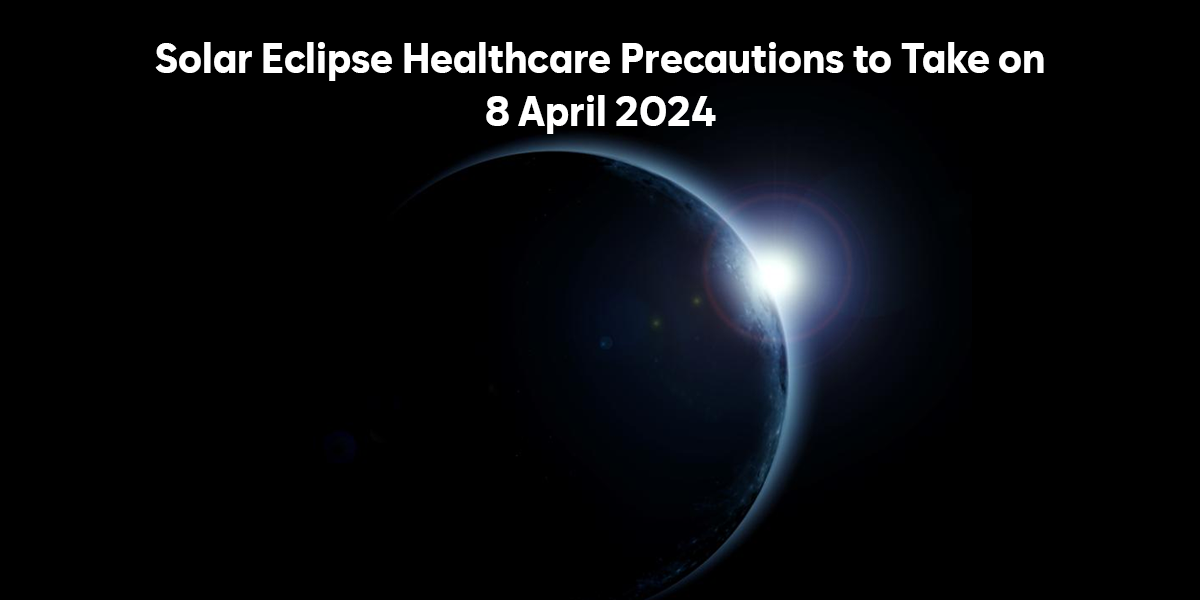On April 8, 2024, the world will witness a spectacular celestial event: a total solar eclipse. As the moon passes between the Earth and the Sun, casting its shadow upon our planet, millions of people will gather to witness this awe-inspiring phenomenon. While it is a breathtaking sight to behold, it’s also crucial to consider the potential health implications that come with viewing a solar eclipse.
Let us discuss essential healthcare precautions to ensure a safe and enjoyable experience on April 8, 2024.
Understanding the Risks
First and foremost, it is essential to understand why observing a solar eclipse can be harmful to your health. The Sun emits powerful ultraviolet (UV) radiation, which can cause severe damage to your eyes if you stare directly at it, even during an eclipse. The intense light can burn the retinas in your eyes, leading to permanent vision loss or even blindness. Furthermore, the Sun’s UV rays can also cause sunburn on your skin, increasing your risk of skin cancer and other dermatological issues.
Use Proper Eye Protection
The most crucial precaution you can take when viewing a solar eclipse is to use proper eye protection. Regular sunglasses, homemade filters, or unapproved viewing devices are not safe for observing the Sun. Instead, invest in a pair of eclipse glasses that meet the international safety standards (ISO 12312-2). These glasses block out harmful UV and infrared radiation, allowing you to safely look directly at the Sun during the eclipse. Make sure your eclipse glasses are in good condition, without any scratches or damage that could compromise their effectiveness.
Alternative Viewing Methods
If you are unable to obtain eclipse glasses or if you prefer not to look directly at the Sun, there are alternative viewing methods you can use. One option is to create a pinhole projector, which projects an image of the eclipse onto a surface such as a piece of paper or cardboard. You can also use a telescope or binoculars with a solar filter to safely observe the eclipse. However, be sure to follow the manufacturer’s instructions carefully and never look through the optical device directly at the Sun.
Protect Your Skin
In addition to safeguarding your eyes, it is essential to protect your skin from the Sun’s harmful rays during the eclipse. Even though the Sun may be partially obscured by the moon, UV radiation can still reach your skin and cause damage. Apply a broad-spectrum sunscreen with a high SPF (30 or above) to any exposed skin, including your face, neck, and hands. Reapply sunscreen regularly, especially if you will be outdoors for an extended period. Wear protective clothing such as long sleeves, pants, and a wide-brimmed hat to further shield your skin from the Sun.
Stay Hydrated and Cool
Depending on where you are located and the time of day, viewing a solar eclipse can expose you to intense heat and humidity. To prevent heat-related illnesses such as heat exhaustion or heatstroke, stay hydrated by drinking plenty of water throughout the day. Avoid alcoholic beverages and caffeinated drinks, as they can contribute to dehydration. If possible, seek shade or take breaks indoors to cool down periodically. Pay attention to your body’s signals, and if you start to feel overheated or unwell, take immediate action to cool off and rest.
Be Mindful of Crowd Safety
Solar eclipses often attract large crowds of spectators, which can present its own set of health and safety challenges. If you plan to attend a public viewing event or gather with friends and family to watch the eclipse, be mindful of crowd safety measures. Practice social distancing, wear a mask if recommended or required, and avoid crowded areas if you feel uncomfortable. Follow any instructions or guidelines provided by event organizers or local authorities to ensure a safe and enjoyable experience for everyone.
Prepare for Potential Traffic
Lastly, be prepared for increased traffic and congestion on the roads on the day of the eclipse, especially in areas where the path of totality passes through. Plan your travel route in advance, allowing extra time to reach your destination and potential delays. Consider carpooling or using public transportation if available to reduce traffic congestion and minimize environmental impact. Be patient and courteous to fellow drivers, and obey all traffic laws and regulations to ensure a smooth and safe journey.
Conclusion
While viewing a solar eclipse is a once-in-a-lifetime experience for many people, it’s essential to prioritize your health and safety. By following these healthcare precautions, you can protect yourself and your loved ones from the potential risks associated with observing the Sun during an eclipse. So, mark your calendars for April 8, 2024, and get ready to witness nature’s grand spectacle safely and responsibly.
FAQs
1)Where is the best place to see the 2024 solar eclipse on 8th April?
The best place to see the 2024 solar eclipse on 8th April would be in North America, particularly in the path of totality which stretches from Mexico, through the United States, and into Canada. Within the United States, prime viewing locations include cities such as Dallas, Little Rock, Indianapolis, Cleveland, Buffalo, and Montreal in Canada.
2)What time is the solar eclipse in USA on 8th April?
The solar eclipse in the USA on 8th April will occur at different times depending on the location within the country. However, the maximum eclipse, or the moment of totality, will vary. For example, in Dallas, Texas, the eclipse will reach its maximum at around 1:45 PM local time, while in cities like Cleveland, Ohio, it will be around 3:13 PM local time.




